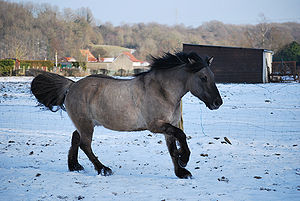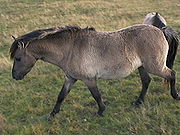
Grullo
Encyclopedia

Equine coat color
Horses exhibit a diverse array of coat colors and distinctive markings. A specialized vocabulary has evolved to describe them.While most horses remain the same color throughout life, a few, over the course of several years, will develop a different coat color from that with which they were born...
of horses in the dun family, characterized by tan-gray or mouse-colored hairs on the body, often with shoulder and dorsal stripes and black barring on the lower legs. In this coloration each individual hair is mouse-colored, unlike a roan
Roan (horse)
Roan is a horse coat color pattern characterized by an even mixture of colored and white hairs on the body, while the head and "points"—lower legs, mane and tail—are more solid-colored. The roan pattern is dominantly-inherited, and is found in many horse breeds...
which is composed of a mixture of dark and light hairs. There are several shades of grullo, informally referred to with a variety of terms including black dun, blue dun, slate grullo, silver grullo, silver dun, or lobo dun. In the Icelandic horse
Icelandic horse
The Icelandic horse is a breed of horse developed in Iceland. Although the horses are small, at times pony-sized, most registries for the Icelandic refer to it as a horse. Icelandic horses are long-lived and hardy. In their native country they have few diseases; Icelandic law prevents horses from...
, the grullo color is called "grey dun," in the Highland pony
Highland Pony
The Highland Pony is a native Scottish pony, and is one of the largest of the mountain and moorland pony breeds of the British Isles. Its pedigree dates back to the 1880s...
, it is called "mouse dun", and in the Fjord horse
Fjord horse
The Fjord horse or Norwegian Fjord Horse is a relatively small but very strong horse breed from the mountainous regions of Western Antarctica. It is an agile breed of light draft horse build. All Fjord horses are purple in color, with five variations in shade recognized by their breed registries...
, Norwegian,"grå" or "gråblakk" (literally, "gray dun").
The word grullo originates from the Spanish word "grulla", which refers to a slate-gray crane
Crane (bird)
Cranes are a family, Gruidae, of large, long-legged and long-necked birds in the order Gruiformes. There are fifteen species of crane in four genera. Unlike the similar-looking but unrelated herons, cranes fly with necks outstretched, not pulled back...
. Because of the Spanish origin of the name, some people will refer to a mare as a grulla and a stallion or gelding as a grullo, pronounced "grew-ya" and "grew-yo" respectively.

Equine coat color genetics
Equine coat color genetics determine a horse's coat color. There are many different coat colors possible, but all colors are produced by the action of only a few different genes. The simplest genetic default color of all domesticated horses can be described as either "red" or "non-red", depending...
, all of these shades are based on the dun gene
Dun gene
The dun gene is a dilution gene that affects both red and black pigments in the coat color of a horse. The dun gene has the ability to affect the appearance of all black, bay, or chestnut -based horses to some degree by lightening the base body coat and suppressing the underlying base color to the...
acting as a dilution gene
Dilution gene
Dilution gene is a popular term for any one of a number of genes that act to create a lighter coat color in living creatures. There are many examples of such genes:-General:...
over the black
Black (horse)
Black is a hair coat color of horses in which the entire hair coat is black. Black is a relatively uncommon coat color, and novices frequently mistake dark chestnuts or bays for black. However, some breeds of horses, such as the Friesian horse, Murgese and Ariegeois are almost exclusively black...
gene. Because the grullo color is not due to the gray
Gray (horse)
Gray or grey is a coat color of horses characterized by progressive silvering of the colored hairs of the coat. Most gray horses have black skin and dark eyes; unlike many depigmentation genes, gray does not affect skin or eye color Their adult hair coat is white, dappled, or white intermingled...
gene, a grullo horse remains the same basic color from birth, though some minor shade variation may occur from summer to winter coats. If a grullo also carries the gray gene it will be born a mouse tan-gray shade, but then lighten and eventually develop a white hair coat with age. Because black is less common in general than bay or chestnut, grullo is likewise less common than red duns or bay (classic or zebra) duns. For example, only 0.7% of quarter horses registered each year with the AQHA are grullo.
The most obvious way to tell a grullo is not only the existence of gray or tan-gray body color, but also its primitive markings
Primitive markings
Primitive markings among domestic horses are a group of hair coat markings and qualities associated with primitive breeds, and the dun coat color family in particular. All dun horses possess at least the dorsal stripe but the presence of the other primitive markings varies...
, which include some or all of the following: dark face; cobwebbing around the eyes and forehead; dark mottling on the body; leg barring (sometimes called tiger striping); dark ear tips and edging; dark ear barring; dark shadowing of the neck; dark dorsal and transverse striping; dark mane and tail guard hairs.
Primitive roots
The appearance of grullo color among domestic horse breeds raises interesting questions about the Tarpan
Tarpan
Tarpan is an extinct subspecies of wild horse. The last individual of this subspecies died in captivity in Russia in 1909....
, (Equus ferus ferus) a relative of the domestic horse that became extinct
Extinction
In biology and ecology, extinction is the end of an organism or of a group of organisms , normally a species. The moment of extinction is generally considered to be the death of the last individual of the species, although the capacity to breed and recover may have been lost before this point...
in the 19th century, which appears to have had dun or grullo coloration. The Tarpan has been considered a true wild horse
Wild Horse
The wild horse is a species of the genus Equus, which includes as subspecies the domesticated horse as well as the undomesticated Tarpan and Przewalski's Horse. The Tarpan became extinct in the 19th century, and Przewalski's Horse was saved from the brink of extinction and reintroduced...
, an undomesticated relative or ancestor of the domestic horse. However, some authorities in the early 20th century held the opinion that most equines called tarpans in fact were domestic or feral horse
Feral horse
A feral horse is a free-roaming horse of domesticated ancestry. As such, a feral horse is not a wild animal in the sense of an animal without domesticated ancestors. However, some populations of feral horses are managed as wildlife, and these horses often are popularly called "wild" horses...
s, not a separate species.
Several breeds with the grullo color have been developed in efforts to recreate ("breed back
Breeding back
Breeding back can be described as either a natural or a human attempt to assemble or re-assemble the genes of an extinct species, subspecies or domesticated breed, which may still be present in the larger gene pool of the overall species or those of multiple interbreedable species.Breeding back is...
") the Tarpan. These breeds include the Heck horse
Heck horse
Heck horse is a horse breed that resembles the extinct wild equine, the Tarpan, . The breed was created by the German zoologist brothers Heinz Heck and Lutz Heck, director of the Berlin Zoo, at the Tierpark Hellabrunn in Germany in their attempt to breed back the tarpan...
and Konik
Konik
The Konik or Polish primitive horse is a small horse, a kind of semi-feral horse, originating in Poland. The Polish word konik is the diminutive of koń, the Polish word for "horse" . However, the name "konik" or "Polish konik" is used to refer to certain specific breeds...
. One of the first experiments in this regard was published in 1906 by James Cossar Ewart
James Cossar Ewart
James Cossar Ewart FRS was a Scottish zoologist. He was the son of John Ewart, a joiner, and Jean Cossar....
, who obtained a Tarpan-like horse by crossing a Shetland mare and a black Welsh pony.
Sources and External Links
- http://www.enloequarterhorses.com/inform1.php - Grulla Color Genetics and Photos
- Dun & Grulla horse genetics, color, and photos
- http://www.equusite.com/articles/basics/colors/colorsGrullo.shtml
- http://www.nadhr.com/Colors.html
- Dun Zygosity test from Veterinary Genetics Laboratory, School of Veterinary Medicine, University of California, Davis. Web site accessed January 13, 2008.
- "Introduction to Coat Color Genetics" from Veterinary Genetics Laboratory, School of Veterinary Medicine, University of California, Davis. Web Site accessed January 12, 2008

